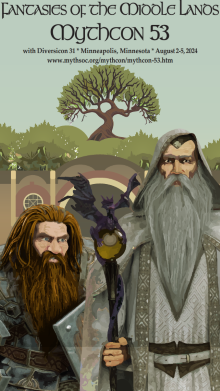Loading...
Location
Albuquerque, NM
Document Type
Paper
Event Website
https://www.mythsoc.org/mythcon/mythcon-52.htm
Start Date
31-7-2022 10:00 AM
End Date
31-7-2022 10:50 AM
Description
N. K. Jemisin’s Broken Earth trilogy made history: each novel won the Best Hugo for Novel (2016-2017-2018). Jemisin is not only the First person to win the novel award three years running, but also the First Black person and the First woman of color to win the novel award. Sony Entertainment purchased the series for adaptation in 2018 (Fleming), and Jemisin will be adapting her series for Film. The Fifth Season has an epic structure (beginning in media res, a quest, world-changing events and characters, and supernatural forces). Given the conventions of the epic genre, my interest in this presentation is how the phenomenological style of Jemisin’s multiple narrative voices, including the use of one second-person and direct address narrator, which intersects with the narrative arc of the female protagonist, a mother, whose epic quest is to save her daughter, subverts reader expectations. My approach, like my earlier publication on Ann Leckie’s Imperial Radch trilogy (Reid), blends linguistics and phenomenology. I use M. A. K. Halliday’s functional grammar to analyze clauses in selected passages (the opening paragraphs of the Prologue and twenty-three chapters in the novel). Phenomenology is the branch of philosophy that focuses on “structures of consciousness as experienced from the first-person point of view” (Stanford). Phenomenological literary studies “regard[s] works of art as mediators between the consciousnesses of the author and the reader or as attempts to disclose aspects of the being of humans and their worlds” (Armstrong). My analysis is informed by Sara Ahmed’s concept of disorientation developed in Queer Phenomenology: Orientations, Objects, Others:
When we are orientated, we might not even notice that we are orientated: we might not even think “to think” about this point. When we experience disorientation, we might notice orientation as something we do not have. After all, concepts often reveal themselves as things to think “with” when they fail to be translated into being or action. (Ahmed, 5-6)
Ahmed defines queer phenomenology is that which “disorients” the reader, specifically, she defines as “bodily experiences that throw the world up, or throw the body from its ground. Disorientation as a bodily feeling can be unsettling, and it can shatter one’s sense of confidence in the ground” (157). I would argue a trilogy that begins with the implication and claim that “the end of the world” is not the most interesting part of the story, in a Prologue subtitled, “you are here” will disorient the majority of readers, and that disorientation is only the start of Jemisin’s disorienting phenomenology.
Included in
“Let’s start with the end of the world, why don’t we?” The Disorienting Phenomenology of N. K. Jemisin’s The Stone Sky
Albuquerque, NM
N. K. Jemisin’s Broken Earth trilogy made history: each novel won the Best Hugo for Novel (2016-2017-2018). Jemisin is not only the First person to win the novel award three years running, but also the First Black person and the First woman of color to win the novel award. Sony Entertainment purchased the series for adaptation in 2018 (Fleming), and Jemisin will be adapting her series for Film. The Fifth Season has an epic structure (beginning in media res, a quest, world-changing events and characters, and supernatural forces). Given the conventions of the epic genre, my interest in this presentation is how the phenomenological style of Jemisin’s multiple narrative voices, including the use of one second-person and direct address narrator, which intersects with the narrative arc of the female protagonist, a mother, whose epic quest is to save her daughter, subverts reader expectations. My approach, like my earlier publication on Ann Leckie’s Imperial Radch trilogy (Reid), blends linguistics and phenomenology. I use M. A. K. Halliday’s functional grammar to analyze clauses in selected passages (the opening paragraphs of the Prologue and twenty-three chapters in the novel). Phenomenology is the branch of philosophy that focuses on “structures of consciousness as experienced from the first-person point of view” (Stanford). Phenomenological literary studies “regard[s] works of art as mediators between the consciousnesses of the author and the reader or as attempts to disclose aspects of the being of humans and their worlds” (Armstrong). My analysis is informed by Sara Ahmed’s concept of disorientation developed in Queer Phenomenology: Orientations, Objects, Others:
When we are orientated, we might not even notice that we are orientated: we might not even think “to think” about this point. When we experience disorientation, we might notice orientation as something we do not have. After all, concepts often reveal themselves as things to think “with” when they fail to be translated into being or action. (Ahmed, 5-6)
Ahmed defines queer phenomenology is that which “disorients” the reader, specifically, she defines as “bodily experiences that throw the world up, or throw the body from its ground. Disorientation as a bodily feeling can be unsettling, and it can shatter one’s sense of confidence in the ground” (157). I would argue a trilogy that begins with the implication and claim that “the end of the world” is not the most interesting part of the story, in a Prologue subtitled, “you are here” will disorient the majority of readers, and that disorientation is only the start of Jemisin’s disorienting phenomenology.
https://dc.swosu.edu/mythcon/mc52/schedule/12



Comments
Paper: Robin Anne Reid
“Let’s start with the end of the world, why don’t we?” The Disorienting Phenomenology of N. K. Jemisin’s The Stone Sky
Tech Mod: Tim Lenz